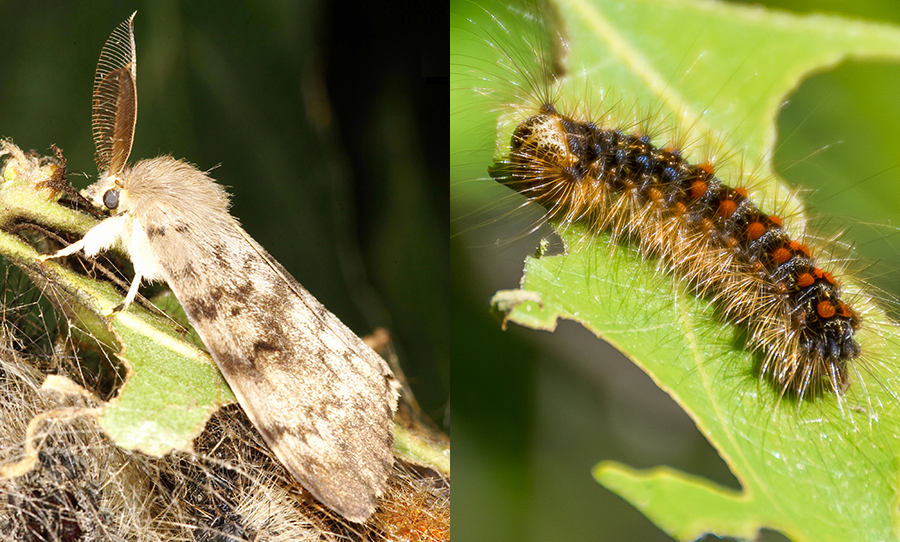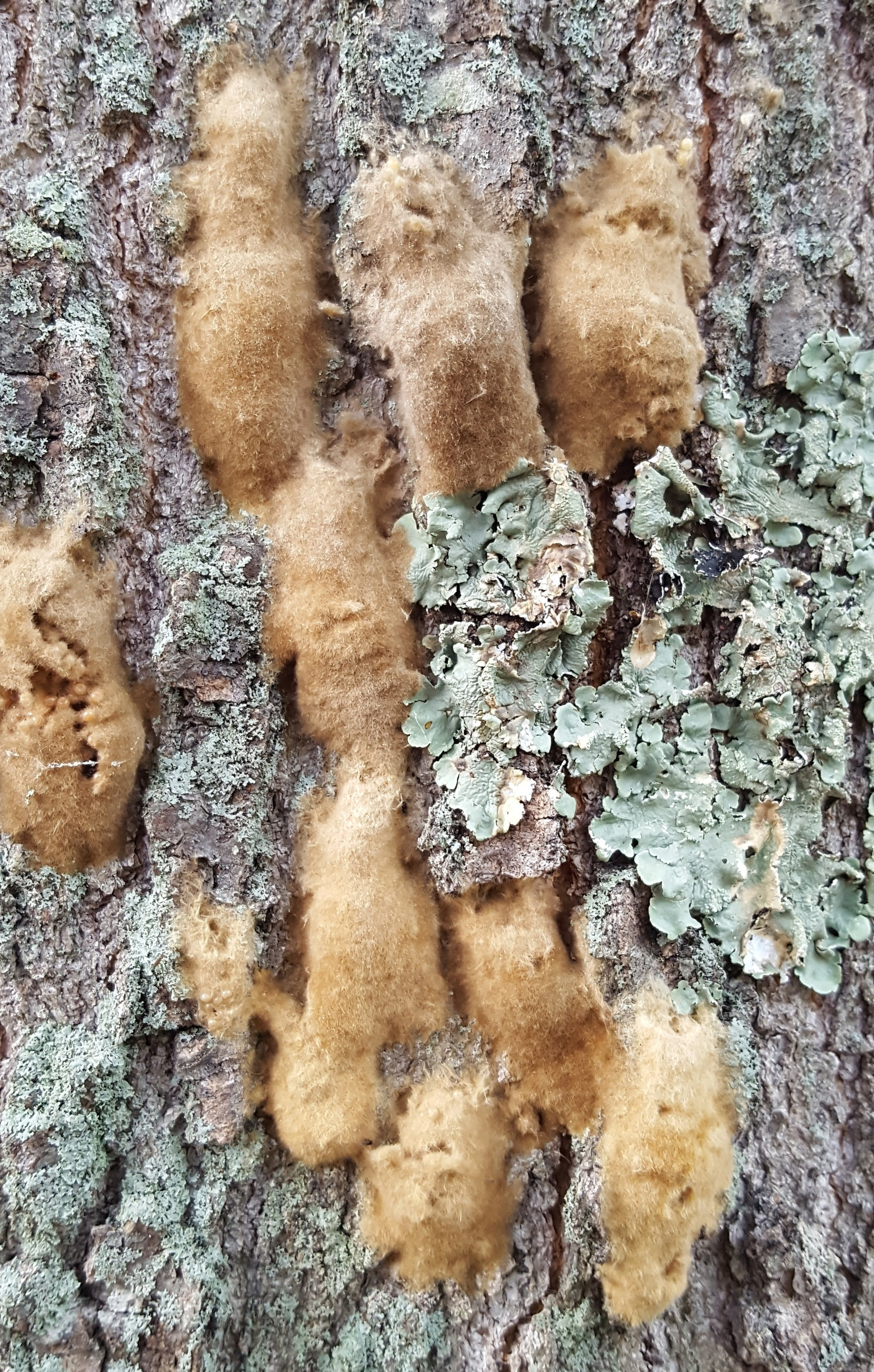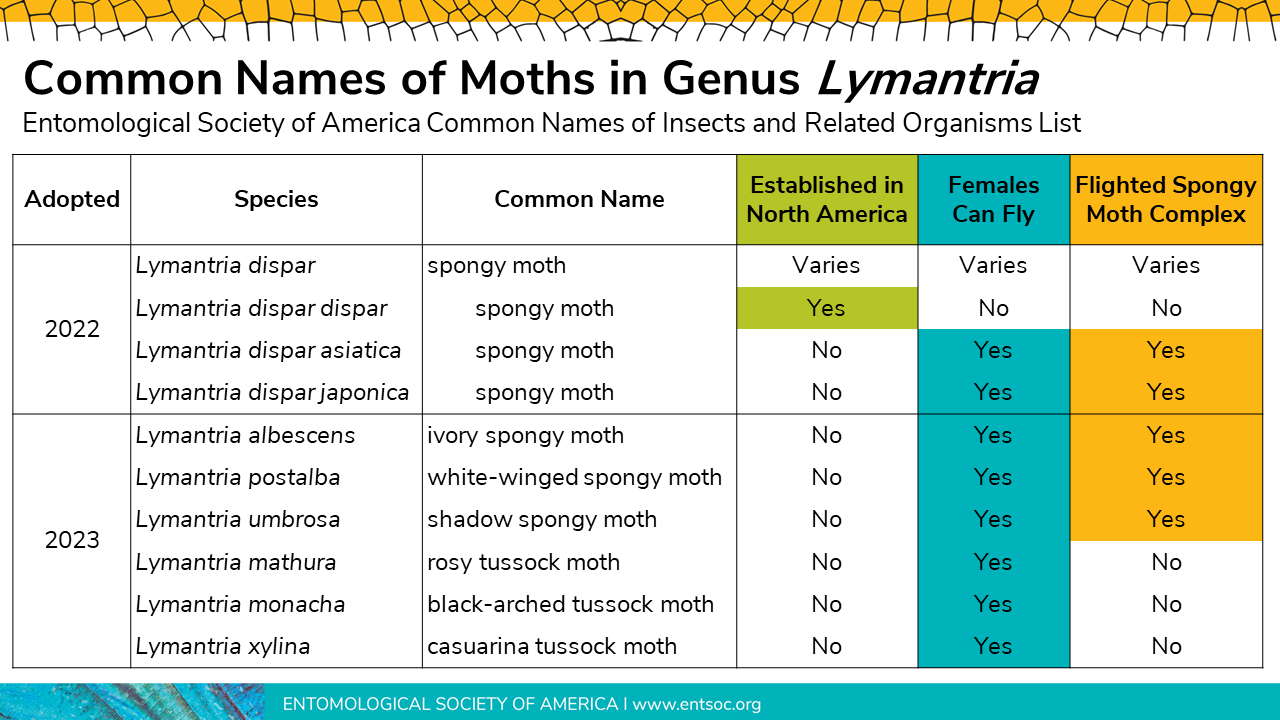
In 2022, the Entomological Society of America adopted "spongy moth" as the common name for the species Lymantria dispar. The name refers to the insect's distinctive sponge-like egg masses and is derived from translations of common names used for the insect in its native range and French-speaking Canada.
The name replaces "gypsy moth," which ESA removed from its list of common names in July 2021 due to "gypsy" being a widely acknowledged ethnic slur and the dehumanizing effects of the common name.
Organizations, media, and individuals are encouraged to adopt "spongy moth" in their communications, documents, and publications related to Lymantria dispar.
The primary goal of this toolkit is to provide individuals and organizations adopting "spongy moth" with information about the change, resources needed to implement the name change, and suggestions for communicating the name change to their stakeholders.
The secondary goal is to help raise awareness of the new name, the importance of control efforts for this invasive species, and the rights of the Roma people.
In 2022, the Entomological Society of Canada also adopted "spongy moth" as the new common name for Lymantria dispar.
In 2023, ESA also adopted common names for six additional species of moths in the genus Lymantria, four of which were often previously known by names using a variation of "gypsy moth," and all of which are included on the 2023 national priority pest list through the U.S. Department of Agriculture Cooperative Agricultural Pest Survey program. Jump to more info on these Lymantria species common names.
(Above photo credits: Lymantria dispar adult by Gyorgy Csoka, Hungary Forest Research Institute, Bugwood.org; Lymantria dispar larva by Karla Salp, Washington State Department of Agriculture, Bugwood.org)
 |
 |
 |
Background on the name change process
The Entomological Society of America (ESA) has approved "spongy moth" as the new common name for the moth species Lymantria dispar. The new name was proposed by a working group of entomologists and forestry professionals convened by ESA. The group was charged with evaluating a wide variety of name options through a combination of professional and community input processes and putting forward an acceptable new common name for the insect. The name "spongy moth" was formally approved by the ESA Governing Board and announced on March 2, 2022.

Lymantria dispar egg masses (Photo by by Karla Salp, Washington State Department of Agriculture, Bugwood.org)
The name spongy moth—derived from the common name used in France and French-speaking Canada, "spongieuse"—refers to the moth's sponge-like egg mass. It will replace "gypsy moth" as the approved common name in ESA's Common Names of Insects and Related Organisms List, from which the former name was removed in July 2021 for its use of a derogatory term for the Romani people.
Lymantria dispar is an invasive pest of deciduous forests that can defoliate hundreds of tree and shrub species. A widely distributed moth native across Eurasian forests, the European subspecies was introduced in Massachusetts in the 1800s and is now widespread in the northeastern United States and eastern Canada and costs hundreds of millions of dollars each year in damage and prevention and control efforts. Other subspecies, such as the asiatica and japonica subspecies, are not established in North America, are potentially even more damaging, and are thus subject to eradication when detected in traps or by the public.
A primary way this moth spreads within the U.S. and Canada is via egg masses transported on firewood, outdoor equipment, personal goods, and vehicles. Public awareness of the L. dispar egg mass, which has a sponge-like appearance, is important in controlling the pest, as the insect spends most of its life cycle (10 months) in the egg stage.
The name "spongy moth" was selected by a working group formed through ESA's Better Common Names Project. The group includes more than 50 scientists and professionals who work in research or forest management settings in both the United States and Canada, as well as Romani scholars working on human rights issues. The group gathered name suggestions and additional input from a broad array of interested individuals and organizations, including entomologists, forestry professionals, federal agencies, state departments of agriculture and natural resources, conservation groups, pest control and plant protection organizations, and Romani people. More than 200 name proposals were evaluated, and a list of seven finalist names was shared with these groups for consideration, with more than 1,000 responses received. View the original proposal form for more information on the process and reasons the final name was selected.
"Spongy moth" will be adopted for use in articles published in ESA's scientific journals and in presentations and posters at ESA conferences, as well as in ESA's website, social media, and public policy documents.
ESA encourages other organizations and individuals who work in research or management of Lymantria dispar to transition to use of the new common name in communications, documents, and publications as time and resources allow in coming months and years.
What was wrong with using the descriptor "gypsy"?
"Gypsy" is a derogatory word used in reference to Roma/Romani people. The European Roma Rights Centre states, "Amongst most Romani communities [gypsy] is an offensive racial slur. It derives from the word 'Egyptian' due to the misconception that Roma arriving in Great Britain originated in Egypt."
Throughout their history, Romani people have been the targets of enslavement, genocide, forced sterilization and migration, economic and social exclusion, and other manifestations of anti-Romani racism. Anti-Romani racism, including institutional racism and discrimination, of Romani people continues today, primarily in Europe where a majority of Romani people live. To learn about the Romani global diaspora, read RomArchive. For information on Romani people, with an emphasis on Romani people in the United States, read the 2020 report from the FXB Center for Health and Human Rights at Harvard University.
"Gypsy moth" was the common name widely used in England at the time the moth arrived in the U.S, and therefore became the common name in the U.S., too. Forbush and Fernald (1896) stated that it is believed that the moth was given its former common name due to the "brown, tanned kind of color of the male" resembling the skin color of Romani people.
In early 2021, ESA adopted new rules for common names that no longer allow references to ethnicities, races, or people groups. In June 2021, the ESA Governing Board voted to remove the previous common name for Lymantria dispar. The decision was made in recognition that "gypsy" is an ethnic slur. The discussion of removing the name was prompted by messages from members, the public, and Roma activists who testified to the name's harmful and dehumanizing effects. While the use of an ethnic slur is enough reason to stop using a common name, the former common name was doubly inappropriate in that it linked a group of people who have been treated as pests and the targets of genocide with an invasive pest insect that remains targeted for population control and eradication, all of which combined to have dehumanizing effects for Romani people.
Furthermore, many of the "positive" connotations of the word "gypsy" are based on harmful stereotypes. For example, Ian Hancock, a professor at the University of Texas at Austin and former representative for the Romani people at the United Nations, told the Washington Post: "These all play into one of the stereotypes; in story books we 'wander' and 'roam,' but as history clearly shows, we were not allowed to stop, and had no choice but to keep moving on."
Prior to ESA removing the old name, several media outlets were discontinuing its use, and large organizations were starting to use alternative names, such as "Ldd moth." ESA saw this as an opportunity to convene a working group of community members to find and agree upon a better common name for the insect rather than having different media outlets and scientific organizations start using new and perhaps differing terms.
The ESA Common Names of Insects and Related Organisms List was created in the early 20th century and has grown to recognize common names for more than 2,300 insect and arthropod species. ESA makes the common names list available as a public resource, and a variety of scientific organizations, extension professionals, and media outlets refer to it.
Transitioning to Spongy Moth: Recommendations and Timelines
ESA encourages organizations and individuals who work in research or management of Lymantria dispar to use the new common name in communications, documents, and publications as time and resources allow after March 2022. Timeframes may differ according to the content type, and a tiered approach may be necessary. For example, websites can generally be updated quickly and at minimal cost, print materials may need to wait until the next print cycle, and regulatory documents may require several years to be fully revised.
As a general timeframe, ESA encourages organizations to fully transition to the new common name by March 2023 where possible.
"Formerly known as"
It may be necessary to temporarily use "formerly known as gypsy moth" to create public awareness of the name change. However, ESA urges organizations to move away from any reference to the old common name as quickly as possible to achieve the goal of eliminating the use of an ethnic slur in this context. While the exact timeframe might differ by content type and audience, in general ESA would suggest using "formally known as" when necessary for the remainder of 2022 and then phasing it out beginning in 2023.
To avoid highlighting the old name, ESA suggests including an asterisk at the new name (e.g., "The spongy moth* is an invasive...") and then placing a brief description at the bottom of the page (e.g., "*A new common name for Lymantria dispar, spongy moth, replaced the prior name of this insect, gypsy moth, in 2022. This change was necessary because the word 'gypsy' is an ethnic slur and the former common name equated people with insects.").
ESA will not use "formally known as" in its own communication materials but will accept its use in some situations, such as journal articles, annual meeting presentations, etc., for the remainder of 2022.
Lymantria dispar subspecies
The adoption of "spongy moth" applies to all subspecies of Lymantria dispar, which includes L. dispar asiatica, L. dispar dispar, and L. dispar japonica. To avoid using geographic descriptors for the subspecies, behavioral and ecological information can be included narratively alongside the Latin subspecies name. For instance, "A single male spongy moth from the subspecies L. dispar asiatica was found in a trap. This type of spongy moth is of regulatory concern, as it is not established in North America and could cause damage to a very wide variety of trees."
Other Lymantria species and the Flighted Spongy Moth Complex
In March 2023, ESA adopted common names for six additional species of moths in the genus Lymantria, following a proposal developed by entomologists and other professionals who work with these moths and a period of community input.
- Lymantria albescens: ivory spongy moth
- Lymantria postalba: white-winged spongy moth
- Lymantria umbrosa: shadow spongy moth
- Lymantria mathura: rosy tussock moth
- Lymantria monacha: black-arched tussock moth
- Lymantria xylina: casuarina tussock moth
Species 1-4 listed above were often previously known by names using a "[descriptor] gypsy moth" construction, and all are closely related Lymantria species included on the 2023 national priority pest list through the U.S. Department of Agriculture (USDA) Cooperative Agricultural Pest Survey program.
In December 2022, as one of several partner nations that regulate selected Lymantria species due to their high risk of dispersal via international trade, the USDA Animal and Plant Health Inspection Service adopted the term "flighted spongy moth complex" for the group of species and subspecies L. albescens, L. postalba, L. umbrosa, L. dispar asiatica, and L. dispar japonica. This group was formerly referred to as Asian gypsy moths, or AGM. Female moths in this group have the ability to fly, which differentiates them from the subspecies L. dispar dispar that is established in North America.

(Download this Lymantria common names chart in PDF, PNG, or PPT format.)
As illustrated above, three of the six species with common names adopted in March 2023 are included in the flighted spongy moth regulatory complex (shaded in yellow).
Also of note: The three subspecies of Lymantria dispar are not listed individually in ESA's Common Names List. Rather, the name "spongy moth" applies to Lymantria dispar and all of its subspecies. ESA's Common Names List typically does not adopt unique common names for individual subspecies. In communicating about L. dispar and its subspecies, ESA suggests the following:
- When no distinction is necessary, use "spongy moth" for L. dispar dispar, L. dispar asiatica, or L. dispar japonica.
- When the key distinction regards female flight capability, "flighted spongy moth" or "member of the flighted spongy moth complex" is suitable for both L. dispar asiatica or L. dispar japonica.
- When distinction among the three subspecies is necessary, use "spongy moth" to refer to them collectively but use scientific names for the subspecies. (Also see "Lymantria dispar subspecies" above.")
The names were proposed by a group of researchers from a range of specialties, functions, locations, and organizations and working in research, management, and outreach on Lymantria moths. The proposed names were then reviewed by the ESA Common Names Committee, posted for a 30-day open comment period, and finally reviewed and approved by the ESA Governing Board in March 2023.
For a summary version of these common names for easy sharing, download this one-page guide to Lymantria species common names.
For an in-depth explanation of the basis for the selected names, see the Lymantrid common name proposal submitted to ESA's Common Names Committee in late 2022.
Specific Information and Recommendations for:
State agencies
State agencies and the control, communications, and outreach programs therein are critical in controlling Lymantria dispar and protecting forests. ESA recommends transitioning to the new common name in public communications (e.g., social media, online presentations) immediately. Throughout 2022, state agencies are encouraged to conduct outreach to stakeholder groups to educate them on the new name. These two activities will set the stage to transition to the new common name fully in 2023. For some materials, such as legal documents, the process may require a longer timeframe.
Regulatory organizations
ESA recognizes that regulatory documents are complex and can take several years to update. ESA will be reviewing other common names for potential changes, and some of those might be regulated species. However, the Better Common Names Project will not change Latin names. Therefore it may be expedient, whenever revisions are required for a single name change, to reword the entire regulation to use only Latin names for all mentioned species.
Museums and collections
For institutions such as museums, collections, or research facilities with voucher specimens that contain the old common name, ESA does not recommend modifying or changing existing specimen labels. Moving forward, ESA encourages using the scientific name, and the new common name if a common name is desired, on all labels and specimens. If museums have public-facing content (such as interpretive signage) that uses the old common name, ESA encourages updating those materials in a timely manner and as budget and capacity allow.
Pesticide labels and pesticide applicators
The Environmental Protection Agency has confirmed with ESA that pesticide labels can be updated gradually as label holders are doing other label-related actions. ESA encourages companies producing labels to update them to the new common or the scientific name as quickly as is feasible. In the meantime, please contact EPA with any labeling concerns.
Extension professionals
ESA encourages extension professionals to discuss the adoption of "spongy moth" with their communities. Explaining that the new common name refers to the sponge-like egg mass is an opportunity to talk about the importance of looking for egg masses on personal property, vehicles, and outdoor equipment whenever leaving a quarantined region.
It may be particularly important for extension professionals to make a plan for how they will approach "formerly known as" wording in their public-facing publications. Refer to the "Formerly Known As" section above for broad guidance.
Social media
ESA encourages immediate transition to "spongy moth" on social media. In posts referencing the name change, it is preferable to link to resources explaining the name change rather than using the former common name or "formerly known as."
Media
In news articles, it may be necessary to refer to the old common name or use "formerly known as" in articles discussing the name change or the insect. ESA encourages a complete transition to the sole use of the new name before the end of 2022.
Journals and journal articles
In ESA journals, authors may use "formerly known as gypsy moth" in association with use of "spongy moth" for the remainder of 2022. Beginning in 2023, authors should use the Latin name primarily, and ESA will require the sole use of the new common name when a common name is referenced. Because past research used the previous common name in the titles of papers, references to the previous common name will be allowed to remain in the references and citations. ESA will not publish correction notices for previously published articles that contain the old common name. Other journals publishing content about Lymantria dispar are encouraged to follow the same approach.
Historical content
The adoption of "spongy moth" is primarily a forward-looking change in which the new name will be used in new materials. The intent of this change is not to require the modification and reprinting of historical materials. For example, old books, journal articles, and outreach materials that use the old common name do not need to be discarded, unless it is deemed important for the transition to the new name (for instance, recycling the last box of an older brochure to prevent confusion for seasonal staff). However, the new common name should be adopted in future new content, revisions of content, and all new printings. For public-facing information in a physical medium, such as signs and handouts, ESA encourages organizations to update and reprint or replace signage and publications as resources and capacity allow.
Databases
Common databases such as the Bugwood databases, BugGuide, and iNaturalist will be updating their systems to use "spongy moth" as the common name.
Sample Communication Text
Below are some sample texts that you can use to communicate with your audiences about the name change.
Sample social media posts
Twitter: Same moth, new name: Lymantria dispar is now known as the "spongy moth," a new common name adopted by @EntsocAmerica. We're joining a broad community of organizations and government agencies in adopting this new name, too. Learn more: https://entsoc.org/news/press-releases/spongy-moth-approved-new-common-name-lymantria-dispar
Facebook or elsewhere: Same moth, new name: The invasive forest pest Lymantria dispar is now known as the "spongy moth," a new common name adopted by the Entomological Society of America. The name refers to the moth's sponge-like egg masses, an important target for management efforts to slow the spread of this invasive insect. We're joining a broad community of organizations and government agencies in adopting this new name, too. Learn more: https://entsoc.org/news/press-releases/spongy-moth-approved-new-common-name-lymantria-dispar
Sample language for newsletter mentions
The Entomological Society of America has approved "spongy moth" as the new common name for the moth species Lymantria dispar. The new common name replaces "gypsy moth" as the approved common name in ESA's Common Names of Insects and Related Organisms List. The old name was removed from this list in July 2021 for its use of a derogatory term for Romani people. The name spongy moth—derived from the common name used in France and French-speaking Canada, "spongieuse"—refers to the moth's sponge-like egg masses. Learn more about the change from the Entomological Society of America.
Sample language for website announcements
The Entomological Society of America changed the common name of Lymantria dispar to "spongy moth." We'll be updating our resources in the coming months to reflect the change. Learn more about the change from the Entomological Society of America.
Sample email text to partners
On March 2, 2022, the Entomological Society of America (ESA) announced "spongy moth" as the new common name for the moth Lymantria dispar. The name refers to the insect's distinctive sponge-like egg masses and is derived from translations of common names used for the insect in its native range and French-speaking Canada.
To align ourselves with other organizations moving to the new common name, we'll be transitioning to "spongy moth" as time and resources allow, and we encourage our partners to do the same.
The new name replaces "gypsy moth," which ESA removed from its list of approved common names in July 2021 due to the term being widely acknowledged as an ethnic slur and the dehumanizing effects of the common name.
For more information about the name change, please visit ESA's spongy moth resource page.
Sample letter to partners
Dear [name]:
On March 2, 2022, the Entomological Society of America (ESA) announced "spongy moth" as the new common name for the species Lymantria dispar, replacing the former common name of "gypsy moth." The new name refers to the insect's distinctive sponge-like egg masses and is derived from translations of common names used for the insect in its native range and French-speaking Canada.
To align ourselves with other organizations moving to the new common name, we'll be transitioning to "spongy moth" as time and resources allow, and we encourage our partners to do the same.
The Entomological Society of America removed the old common name from its list of approved common names in July 2021 due to the term being widely acknowledged as an ethnic slur. ESA has been the arbiter of common names of insects and related arthropods in the United States since 1908.
Lymantria dispar is an invasive pest of deciduous forests that can defoliate hundreds of tree and shrub species. A widely distributed moth native across Eurasian forests, the European subspecies (Lymantria dispar dispar) was introduced in the United States in the 1800s and is now widespread in the northeastern United States and eastern Canada. The moth costs hundreds of millions of dollars each year in damage and prevention and control efforts. Other subspecies, such as L. d. asiatica and L. d. japonica, that are potentially more damaging are not established in North America and are thus subject to eradication when detected.
A primary way the moth spreads in the USA and Canada is via egg masses transported on firewood, outdoor equipment, personal goods, and vehicles. Public awareness of the L. dispar egg mass is important in controlling the pest, as the insect spends most of its life cycle (10 months) in the egg stage.
The name "spongy moth" was selected by a working group of scientists and professionals who work in research or forest management settings in both the United States and Canada, as well as Romani scholars working on human rights issues. The group gathered name suggestions and additional input from a broad array of interested individuals and organizations, including entomologists, forestry professionals, federal and state agencies, conservation groups, and pest control and plant protection organizations.
For more information about the name change, as well as a toolkit to aid transition to the new name, please visit entsoc.org/spongymoth.
Sincerely,
[organization]
Downloadable Resources
- Example transition checklist
- Letter from ESA on ESA letterhead
- QR code linking to the spongy moth resource page
- Flyer announcing name change
Talking Points
Click here to view some talking points that may be helpful when discussing the new name with your partners.
- The Entomological Society of America has approved "spongy moth" as the new common name for Lymantria dispar. The Entomological Society of Canada has also adopted the new common name.
- The name is a reference to the insect's distinctive sponge-like egg masses.
- The name is derived from translations of common names used for the insect in its native range and French-speaking Canada.
- The name replaces "gypsy moth," which the Entomological Society of America removed from its list of approved common names in July 2021 due to "gypsy" being an acknowledged ethnic slur.
- ESA has been the arbiter of common names of insects and related arthropods in the United States since 1908.
- Organizations are encouraged to transition to the new common name in communications, documents, and publications as time and resources allow in coming weeks, months, and years.
Frequently Asked Questions
Click here to view common questions you might get from your partners or that you might have yourself.
Where did the new name come from?
Spongy moth is a translation of the common name used in France and French-speaking Canada, "spongieuse," and relates to common names used in other parts of the insect's native range, such as Germany and Turkey, which can be translated as "sponge-spinner," "sponge-knitter," or "sponge silkmoth."
Why was spongy moth selected as the final name?
Spongy moth met more of the criteria for an acceptable common name than any other of the candidate names, including brevity, ease of pronunciation, use of vocabulary familiar to the public, descriptive of part of the insect's biology, lack of reference to another insect, historical precedence, use in other regions of the world, avoidance of negative language, utility in communicating about management of the pest, and avoidance of references to stereotypes of Romani people.
What was wrong with the old common name?
"Gypsy" is a slang term used for Romani people and is widely acknowledged as an offensive racial slur by Romani people. The use of any ethnic slur in a common name is inappropriate, and therefore it needed to be changed.
Isn't "gypsy" a positive term, meaning wanderer or free-spirited person?
While some people may not have negative connotations with the term, even the "positive" connotations are based on stereotypes that negatively affect the Romani people.
What other names were considered? Why weren't any other shortlist names selected?
Over 200 unique names were considered, including new names and translations of names currently in use or used historically. The full list can be found in the formal proposal form for spongy moth. To select the final name from the shortlist, the working group factored in poll results and comments from individuals and organizations.
Who was involved in the renaming?
The name "spongy moth" was selected as the finalist by the steering committee of a working group formed through the Entomological Society of America's Better Common Names Project. The working group included more than 50 scientists and professionals who work in research or forest management settings in both the United States and Canada, as well as Romani scholars working on human rights issues. There were several polls and comment opportunities that were shared broadly with stakeholder groups.
What prompted the name change?
Several factors influenced the decision to change the name. In 2020, ESA began receiving comments from members requesting the name be changed. ESA then reached out to Romani scholars who testified to the dehumanizing effects of the common name and requested it to be changed. Furthermore, some media outlets and large scientific organizations ceased using the common name. In March 2021, ESA adopted new common name rules that prohibited, among other things, references to ethnic and racial groups, which then resulted in the removal of the old common name from the list of approved common names.
Why does ESA get to change the name?
The ESA Common Names of Insects and Related Organisms List was created in the early 20th century to improve communication between the scientific community and the public and has grown to recognize common names for more than 2,300 insect and arthropod species. ESA makes the common names list available as a public resource, and a variety of scientific organizations, extension professionals, and media outlets refer to it.
What countries does the name change apply to?
ESA's list of common names is intended to reflect common names in the United States. Other countries and communities often have their own unique common names for an insect. This common name change applies to use in the United States. In addition, the Entomological of Canada has decided to change the common name for Lymantria dispar to "spongy moth." If other countries currently use "gypsy moth" or translations thereof as a common name, ESA encourages the adoption of a new name.
Are other names being changed right now?
At this time, only Lymantria dispar is receiving a new common name. When the old common name for Lymantria dispar was removed, a common name for an ant species, Aphaenogaster araneoides, that shared the same term was also removed, but there are no plans to propose a new common name.
Will other names be changed in the future?
Most likely. As part of the Better Common Names Project, ESA is reviewing the list of common names to determine which (if any) should be changed, but no decisions on specific names have been made yet.
Further Information
Information about Lymantria dispar
- USDA APHIS information on regulation and management of Lymantria dispar; Lymantria dispar dispar; and Lymantria dispar asiatica, Lymantria dispar japonica, Lymantria albescens, Lymantria umbrosa, Lymantria postalba
- Information on Lymantria dispar from the U.S. Forest Service Northern Research Station.
- Slow the Spread Program, a program dedicated to slowing the spread of Lymantria dispar throughout the United States
- CABI datasheet on Lymantria dispar
- Information about Lymantria dispar from the Invasive Species Centre
- University of Massachusetts – Amherst fact sheet on Lymantria dispar:
- Don't Move Firewood Invasive Species Profiles
- Photos of Lymantria dispar from Bugwood
Information about the Roma people
- Romani Realities in the United States: Breaking the Silence, Challenging the Stereotypes (Harvard)
- The Roma in Europe: 11 things you always wanted to know but were afraid to ask (Amnesty International
- Fascination and Hatred: The Roma in European Culture (National WWII Museum)
- European Roma Rights Centre
- European Roma Institute for Arts and Culture
- RomArchive – Digital Archive of the Roma
